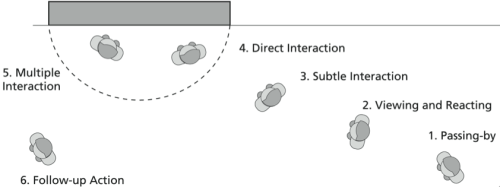Figure: The Audience Funnel framework
(Michelis, Müller (2011) International Journal of Human-Computer Interaction Volume 27, Issue 6)
Paper Abstract
Data are presented from observations of Magical Mirrors, a set of four large public displays with gesture-based interaction installed in downtown Berlin, Germany. The displays show a mirror image of the environment in front of them and react with optical effects to the gestures of the audience. Observations of audience behavior revealed recurring behavioral patterns, like glancing at a first display while passing it, moving the arms to cause some effects, then directly approaching one of the following displays and positioning oneself in the center of the display. This was often followed by positioning oneself in the center of the other displays to explore the possibilities of the different effects, and sometimes by taking photographs or videos. From these observations a framework of interaction with gesture-based public display systems was deduced. It describes the phases of passing by a display, viewing & reacting, subtle interaction, direct interaction, multiple interactions, and follow-up actions. Quantitative data of these behavioral phases was collected by observing 660 passers-by on 2 weekend evenings. This article shows how many passers-by pass the thresholds between these phases. This “Audience Funnel” should provide a framework to encourage systematic investigation of public display systems and enable comparability between different studies.
Download full text on the publisher’s website.








Recent Comments